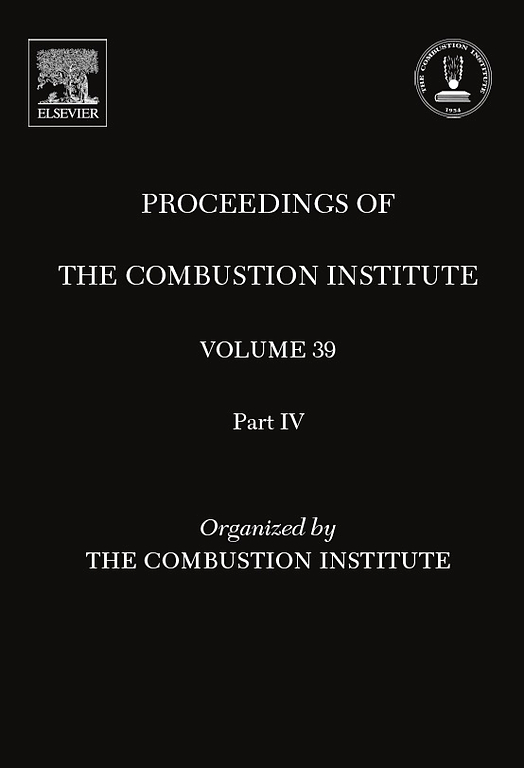Influence of substrate, precursor, flow field, and hydrogen etching on the flame synthesis of monolayer graphene films
IF 5.3
2区 工程技术
Q2 ENERGY & FUELS
引用次数: 0
Abstract
Graphene films are grown in an open atmosphere on metal substrates using a modified multiple inverse-diffusion flame (m-IDF) burner with hydrogen as fuel and hydrocarbon as precursor (delivered by multiple distinct tubes staged above the m-IDF burner surface). The flame synthesis procedure uses three stages consisting of () pretreatment, () growth, and () hydrogen etching and produces monolayer graphene (MLG) films with methane as a precursor on copper substrates at 1000 °C. Substrate material (e.g., copper, nickel, silicon), purity, and smoothness (i.e., unpolished, electropolished); precursor composition (i.e., CH, CH, CH); substrate orientation (i.e., parallel, perpendicular, tilted 45˚) with respect to the post-flame flow field; and post-growth in-situ hydrogen etching are investigated for their impact on the quality (i.e., defect level, graphitic structure), uniformity, and number of layers of the as-synthesized graphene films. On low-purity Cu Substrates, defects are observed because of the impurity content. Interestingly, on smooth electropolished Cu substrates, high defect levels are produced presumably because of the high nucleation rates and density from the higher flow rates used in flame synthesis. When using CH and CH as precursors versus CH, growth rates are slower although the graphene film characteristics are similar. The small substrate sizes used are not in the boundary-layer regime, so the substrate orientation does not affect the characteristics of the film. The initial quality of graphene films and the substrate materials are the two key factors controlling the hydrogen etching effect and the healing effect because of thermal recrystallization. Hydrogen annealing can remove adlayers and improve the quality of graphene on Cu but has minimal or detrimental effects on films on other substrate materials.基底、前驱体、流场和氢蚀刻对火焰合成单层石墨烯薄膜的影响
石墨烯薄膜是使用改良的多重反向扩散火焰(m-IDF)燃烧器,以氢气为燃料,碳氢化合物为前驱体(由 m-IDF 燃烧器表面上方的多个不同管道输送),在开放的大气环境中在金属基底上生长的。火焰合成过程包括()预处理、()生长和()氢气蚀刻三个阶段,在 1000 °C 的温度下,以甲烷为前驱体在铜基底上生成单层石墨烯(MLG)薄膜。基底材料(如铜、镍、硅)、纯度和光滑度(如未抛光、电抛光);前驱体成分(如 CH、CH、CH);基底取向(如平行、垂直、倾斜)、研究了这些因素对合成的石墨烯薄膜的质量(即缺陷程度、石墨结构)、均匀性和层数的影响。在低纯度的铜基板上,由于杂质含量高,会观察到缺陷。有趣的是,在光滑的电抛光铜基底上,可能由于火焰合成中使用的较高流速产生了较高的成核率和密度,从而产生了较高的缺陷水平。使用 CH 和 CH 作为前驱体与 CH 相比,虽然石墨烯薄膜的特性相似,但生长速度较慢。使用的小尺寸衬底不属于边界层体系,因此衬底的取向不会影响薄膜的特性。石墨烯薄膜的初始质量和基底材料是控制氢气刻蚀效应和热再结晶愈合效应的两个关键因素。氢退火可以去除附着层,提高铜基石墨烯的质量,但对其他基底材料上的薄膜影响很小,甚至有害。
本文章由计算机程序翻译,如有差异,请以英文原文为准。
求助全文
约1分钟内获得全文
求助全文
来源期刊

Proceedings of the Combustion Institute
工程技术-工程:化工
CiteScore
7.00
自引率
0.00%
发文量
420
审稿时长
3.0 months
期刊介绍:
The Proceedings of the Combustion Institute contains forefront contributions in fundamentals and applications of combustion science. For more than 50 years, the Combustion Institute has served as the peak international society for dissemination of scientific and technical research in the combustion field. In addition to author submissions, the Proceedings of the Combustion Institute includes the Institute''s prestigious invited strategic and topical reviews that represent indispensable resources for emergent research in the field. All papers are subjected to rigorous peer review.
Research papers and invited topical reviews; Reaction Kinetics; Soot, PAH, and other large molecules; Diagnostics; Laminar Flames; Turbulent Flames; Heterogeneous Combustion; Spray and Droplet Combustion; Detonations, Explosions & Supersonic Combustion; Fire Research; Stationary Combustion Systems; IC Engine and Gas Turbine Combustion; New Technology Concepts
The electronic version of Proceedings of the Combustion Institute contains supplemental material such as reaction mechanisms, illustrating movies, and other data.
 求助内容:
求助内容: 应助结果提醒方式:
应助结果提醒方式:


